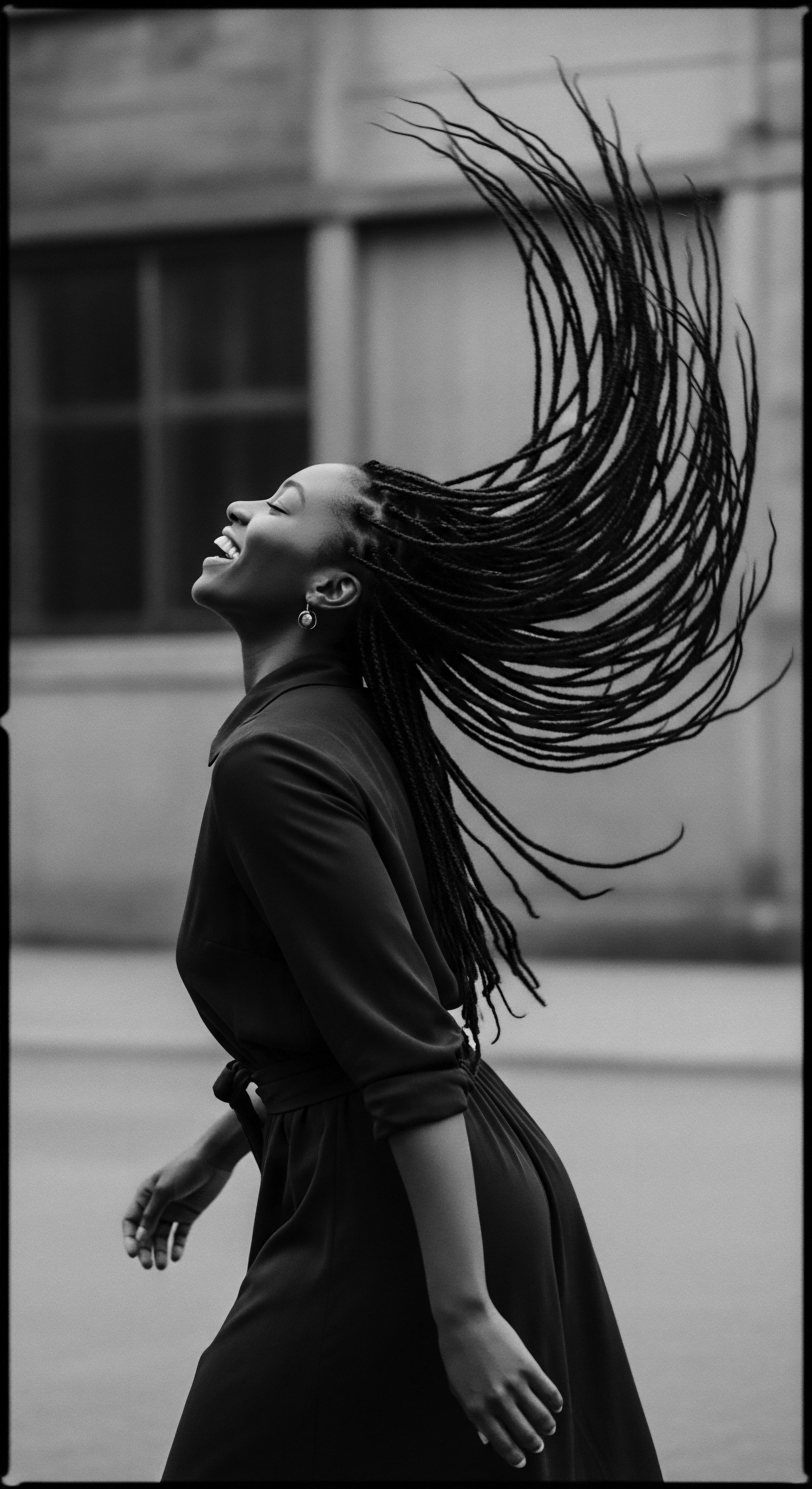
Roots
Consider for a moment the silent chronicle held within each strand that crowns your head, a living archive of generations past. For those with textured hair, this crown speaks volumes, tracing lines of descent, of journeys, and of wisdom passed through the gentle touch of hands long vanished, yet present in every ritual of care. What ancestral wisdom guides gentle detangling of textured hair?
It is not a question confined to method alone, but an invitation to unearth a profound legacy, a lineage of care that begins with the very architecture of our coils and kinks. Our hair, in its myriad forms—from broad waves to tightly wound spirals—possesses an inherent design that is both wonderfully resilient and, at times, deceptively delicate.
The unique helices of textured hair, characterized by their elliptical shaft shape, create numerous points where strands naturally intertwine. This structural predisposition, a biological signature, means that gentle detangling is not merely a preference; it becomes a fundamental necessity for maintaining the integrity of the hair shaft. Understanding this elemental biology, however, is incomplete without recognizing the ancestral knowledge that pre-dates modern science.
For centuries, communities across the African continent and its diaspora possessed an intuitive grasp of how to work with, rather than against, this natural inclination. They developed systems of care that honored the hair’s tendency to intertwine, transforming a potential challenge into a practice steeped in intention and connection.

The Sacred Geometry of Hair
Long before microscopes revealed the secrets of the hair cuticle, African civilizations understood the distinct nature of their hair. They observed its tendency to coil, its thirst for moisture, and its capacity to hold intricate styles. This observation shaped their methods. Hair, in many pre-colonial African societies, was revered as the most elevated part of the body, a conduit to the spiritual realm and a repository of personal and collective history.
Its styling, therefore, transcended mere adornment; it served as a means of communication, reflecting one’s age, marital standing, familial ties, and societal role. The very act of care, including the separation of strands, was imbued with this spiritual significance. This ancient reverence for the hair’s innate structure, its sacred geometry, informed every gesture.
The inherent design of textured hair, with its unique coiling patterns, demands a deliberate and thoughtful approach to detangling, a wisdom recognized by ancestors through centuries of care.

Early Tools and the Hand’s Memory
The earliest tools for detangling were, perhaps, the most intuitive ❉ the fingers themselves. The human hand, with its sensitive touch, could discern knots, navigate coils, and gently separate strands without causing undue stress. This method, known today as Finger Detangling, echoes an ancient practice, relying on tactile feedback and patience. As societies progressed, tools crafted from natural elements emerged.
Combs carved from wood, bone, or ivory have been discovered in archaeological sites from ancient Kush and Kemet, dating back over 5,500 years. These combs, often adorned with symbolic carvings, attest to the deep spiritual value placed on hair and its grooming instruments. They were not simple implements, but extensions of a culturally rich practice, designed to complement the hair’s natural direction of growth and reduce snagging.
- Omutyuula Tree Bark ❉ Used by Mbalantu women of Namibia, mixed with fat for hair growth and conditioning, which in turn aids manageability.
- Shea Butter ❉ A staple across various African tribes, providing moisture and protection, softening hair to assist in detangling.
- Aloe Vera ❉ Utilized in ancient Latin American and Native American traditions for conditioning and promoting hair health, contributing to smoother strands.
The ancestral lexicon for textured hair care, while not always translated directly into modern scientific terms, implicitly understood the principles of moisture, lubrication, and gentle manipulation. Water, in its purest form, served as a primary detangling agent, allowing hair to become supple. Oils, derived from plants and animals, provided slip, coating the hair shaft to ease the separation of tangled sections. This foundational understanding, rooted in centuries of observation and passed down through oral traditions, laid the groundwork for the gentle practices that persist today.
| Traditional Agent Water |
| Ancestral Understanding Softens hair, provides pliability for manipulation. |
| Modern Scientific Link Increases elasticity, reduces friction by swelling the hair shaft. |
| Traditional Agent Plant Oils (e.g. Shea, Coconut) |
| Ancestral Understanding Adds sheen, protects from harsh elements, eases separation. |
| Modern Scientific Link Provides lubricity, reduces frizz, penetrates the cuticle for moisture retention. |
| Traditional Agent Fingers |
| Ancestral Understanding Intuitive navigation of knots, allows for careful unraveling. |
| Modern Scientific Link Minimizes tension, preserves length by avoiding harsh pulling. |
| Traditional Agent Ancestral practices intuitively leveraged natural elements and the human touch, principles now validated by contemporary hair science. |
The historical journey of textured hair reveals a continuum of adaptation and resilience. From the deliberate shaving of heads during the transatlantic slave trade, a cruel attempt to strip identity and erase cultural markers, enslaved Africans, nonetheless, found ways to preserve fragments of their hair care heritage. They improvised with available materials, using sheep-fleece carding tools to detangle their hair and applying substances like butter or animal fats for moisture.
This period, marked by immense struggle, did not extinguish the deep connection to hair but rather underscored its significance as a symbol of identity and resistance. The hair’s inherent capacity for density and its ability to intertwine, while sometimes presenting challenges, also offered opportunities for protective styles, which served both aesthetic and practical purposes under harsh conditions.

Ritual
Engaging with textured hair, particularly in the act of detangling, transcends simple grooming; it steps into the realm of ritual. This is a deliberate, mindful interaction with one’s living heritage, a practice that has flowed through generations, gaining depth and meaning with each passing hand. The tenderness applied to each coil, the patience extended to every tangle, these are not accidental gestures.
They are echoes of ancient customs, where hair care was a communal event, a time for sharing stories, wisdom, and strengthening familial bonds. This communal aspect, a cornerstone of many ancestral societies, transforms what could be a solitary chore into a shared experience of connection and care.

A Gentle Unfolding
The ancestral approach to detangling was often characterized by a profound respect for the hair’s natural state. It began, not with force, but with preparation, a pre-detangling ceremony that softened the strands and made them pliable. This preparation frequently involved the generous application of water, followed by natural oils or herbal infusions. The purpose was to hydrate the hair, providing the necessary “slip” to allow knots to loosen with minimal resistance.
Imagine the warmth of hands working these preparations into the hair, the quiet murmurs of guidance, the scent of shea or coconut, filling the air. This careful conditioning before detangling minimized breakage, a testament to an intuitive understanding of hair elasticity.
Detangling textured hair, when approached as a ritual, honors a heritage of deliberate preparation, gentle touch, and the communal passing of ancestral wisdom.

Sectioning and Systematic Approaches
One of the most enduring and effective ancestral practices in detangling involves Sectioning the hair. By dividing the hair into smaller, manageable portions, individuals could focus their attention on one area at a time, preventing re-tangling and reducing overall strain. This systematic approach, observed in traditional braiding and styling practices across Africa, demonstrates a pragmatic wisdom. It allows for thoroughness and a decrease in tension on the scalp and hair shaft.
Whether preparing for intricate cornrows or simple twists, the meticulous division of hair was, and remains, a fundamental step in gentle care. This meticulousness not only supports hair health but also creates the groundwork for the elaborate styles that signify so much within communities.
The choice of tool also held significance. While fingers remained primary, wide-tooth combs, often handmade, were valued for their ability to glide through coils without excessive pulling. The philosophy guiding their use was patience; starting from the ends and slowly working towards the roots, never forcing the comb through resistance.
This contrasts sharply with later practices that sometimes prioritized speed over preservation, leading to damage. The ancestral method prioritizes the longevity and health of the strand over quick results, a reflection of hair’s value as a marker of identity and well-being.
- Pre-Conditioning ❉ Applying water and nourishing oils or butters (such as Shea Butter or Coconut Oil) to soften strands before beginning the process.
- Finger Work First ❉ Utilizing the sensitive touch of the fingers to gently loosen larger knots and separate sections, minimizing tension on the scalp.
- Sectioning ❉ Dividing the hair into smaller, manageable portions, which allows for focused attention and prevents re-tangling of previously detangled areas.
- End-To-Root Progress ❉ Beginning at the very ends of the hair and gradually working the comb or fingers upwards towards the root, addressing smaller tangles as they arise.
| Era/Context Pre-Colonial Africa |
| Primary Detangling Tools Fingers, carved wooden/bone combs |
| Guiding Principle Hair as sacred, patience, communal bonding, preservation of length. |
| Era/Context Slavery/Post-Emancipation |
| Primary Detangling Tools Improvised tools (e.g. wool carders), limited access to proper combs |
| Guiding Principle Survival, resilience, minimal maintenance due to harsh conditions. |
| Era/Context Modern Natural Hair Movement |
| Primary Detangling Tools Wide-tooth combs, detangling brushes, fingers |
| Guiding Principle Reclamation of heritage, holistic health, self-acceptance, length retention. |
| Era/Context Tools and methods for detangling have adapted through history, yet the core principle of gentle, purposeful care, deeply rooted in heritage, persists. |
This ritual of care, passed from elder to youth, transcended mere technique. It taught patience, the deep value of the hair, and the importance of self-preservation within communities that faced systemic challenges to their identity. The “wash day” ritual, a deeply personal and often communal experience for Black and mixed-race families, owes its structure to these enduring ancestral practices.
Stories are shared, songs sung, and the very act of detangling becomes a vehicle for transmitting cultural narratives and family history. This legacy of tender care, therefore, becomes a quiet act of self-love and cultural affirmation, a living thread connecting past generations to the present moment.

Relay
The transmission of ancestral wisdom concerning gentle detangling of textured hair forms a living relay, a continuous transfer of knowledge that links the ingenuity of past generations to the practices of today. This is a dialogue between tradition and contemporary understanding, where age-old methods often find validation in modern scientific inquiry. It highlights the profound efficacy of approaches honed over centuries, revealing how deeply observant and attuned our ancestors were to the biological realities of hair, long before laboratories and microscopes became commonplace.

Historical Narratives of Hair Care Endurance
Consider the Mbalantu women, an ethnic group residing in northern Namibia and southern Angola. Their renowned hair rituals offer a compelling case study of ancestral wisdom guiding textured hair care and, by extension, gentle detangling. From approximately twelve years of age, Mbalantu girls begin a meticulous process that culminates in ankle-length hair. This involves coating their hair with a thick paste made from the finely ground bark of the Omutyuula Tree (Acacia reficiens) mixed with fat.
This mixture is reapplied over years, contributing to extraordinary length and, one can surmise, enhanced manageability of the hair through constant lubrication and protection. The long, heavy plaits, known as Eembuvi, are tended with incredible patience and skill, signifying various life stages and social standing. This tradition represents more than just a style; it embodies a holistic, lifelong dedication to hair health and presentation, where the very act of preparing and maintaining such lengths inherently necessitates gentle, consistent detangling. The careful handling, the regular application of nourishing agents, and the systematic sectioning for braiding all contribute to minimizing breakage and maintaining the integrity of these remarkable tresses.
Ancestral wisdom in detangling embodies a holistic approach, often validated by contemporary science, transforming practical care into a profound act of heritage preservation.
The deep historical commitment to hair care, even under duress, further illustrates this relay of wisdom. During the horrific period of the transatlantic slave trade, enslaved Africans, stripped of their traditional tools and nourishing ingredients, improvised. They used materials at hand, such as sheep-fleece carding tools to detangle their hair and household fats like butter or bacon grease for conditioning.
This adaptation speaks volumes about the enduring value placed on hair care, not just for aesthetic reasons, but as a silent act of preserving identity and connection to a lost homeland. The fact that detangling, even with limited resources, persisted as a practice underscores its fundamental role in maintaining hair, however challenging the circumstances.

What Can Modern Science Verify about Ancient Detangling Practices?
Modern trichology and material science increasingly confirm the efficacy of these traditional approaches. The elliptical cross-section and unique curl patterns of textured hair mean that cuticle scales are not as tightly laid as in straight hair, making it more susceptible to moisture loss and tangling. Ancestral practices instinctively countered these challenges. The use of oils and natural butters, for instance, provides emollients that seal moisture into the hair shaft, reducing friction between strands and allowing them to glide past one another more easily during detangling.
This mechanism is precisely what modern conditioners aim to replicate with synthetic polymers. The consistent application of hydrating and lubricating agents, as seen with the Mbalantu women’s omutyuula paste, addresses the inherent dryness of textured hair, which is a major contributor to knots and breakage.

How do Ancestral Preparation Rituals Reduce Hair Damage?
The emphasis on saturating hair with water or herbal infusions before detangling, a common ancestral practice, leverages the physical properties of hair. When hair is wet, its elasticity significantly increases, making it less prone to snapping under tension. Moreover, the presence of water acts as a natural lubricant.
This deliberate dampening of hair before manipulation reduces mechanical stress, preventing the microscopic damage that accumulates over time and leads to split ends and breakage. The wisdom of pre-detangling with water and natural oils is a testament to acute observation and understanding of hair’s vulnerable state when dry.

What Role Did Community Play in Preserving Detangling Techniques?
The communal aspect of hair care, prevalent in many African societies, served as a powerful mechanism for knowledge transfer. Hair grooming was not a solitary act but a shared experience, often among women, where techniques, tips, and the philosophy of care were directly demonstrated and internalized. The patience required for detangling, the specific motions of the hands, the optimal amount of product, the recognition of different hair textures within a single family—these nuances were passed down through observation, verbal instruction, and repeated practice.
This collective memory ensured the continuity of gentle detangling methods, adapting them slightly across generations while retaining their core effectiveness and cultural significance. This intergenerational sharing created a resilient repository of hair wisdom, a legacy that continues to influence care practices today.
| Ingredient Water |
| Traditional Use in Hair Care Cleansing, softening, promoting pliability. |
| Benefit for Detangling Hydrates and expands hair shaft, reducing friction and making knots easier to loosen. |
| Ingredient Coconut Oil |
| Traditional Use in Hair Care Moisturizing, strengthening, adding shine. |
| Benefit for Detangling Deeply penetrates hair, providing slip and lubrication for smoother comb passage. |
| Ingredient Shea Butter |
| Traditional Use in Hair Care Protective barrier, intensive moisturizer. |
| Benefit for Detangling Coats strands, softens hair, and aids in the gentle separation of tangles. |
| Ingredient Aloe Vera |
| Traditional Use in Hair Care Soothing scalp, conditioning hair. |
| Benefit for Detangling Gel-like consistency provides natural slip, helps detangle and adds moisture. |
| Ingredient These natural elements, revered in ancestral practices, offered synergistic benefits that directly support gentle detangling and overall hair resilience. |
The knowledge relay extends to the spiritual and psychological dimensions of hair care. For many, hair is not merely dead protein; it is alive, connected to spirit, identity, and community. Detangling, when performed with intention and mindfulness, becomes a meditative practice, a moment of connection with self and lineage. This perspective, deeply embedded in ancestral philosophies, transforms the act from a task into a sacred ritual, reinforcing its importance as a means of honoring one’s heritage.
The resilience of textured hair itself, its capacity to endure and rebound, mirrors the resilience of the communities from which these traditions spring. It is a powerful cultural statement, a visible link to a rich and often challenging past, always held with reverence.

Reflection
To consider ancestral wisdom in the gentle detangling of textured hair is to lean into a vast, living library. This library is not bound by parchment or digital screens, but by the very cellular memory of our strands, by the enduring power of practiced hands, and by the whispers of generations. The journey of textured hair—from the vibrant expressions of identity in pre-colonial African societies, through the forced adaptations of the diaspora, to its reclamation in contemporary times—is a testament to an unbreakable spirit. It is a saga written in every coil, every braid, every intentional stroke of a wide-tooth comb.
The ‘Soul of a Strand’ ethos reminds us that each hair on our head carries a narrative, a whisper of the past, a hope for the future. Gentle detangling, therefore, is not merely a method for avoiding breakage; it is a profound engagement with that narrative. It is an act of listening, of honoring, and of preserving a lineage of beauty and strength. When we reach for the comb, or simply our fingers, with patience and presence, we are not just caring for hair.
We are participating in a timeless ritual, one that connects us to ancestral knowledge and empowers us to carry that legacy forward. The resilience woven into the very structure of textured hair speaks to the unyielding spirit of the people who wear it, a spirit that has consistently found ways to celebrate and sustain its beauty, despite all attempts to diminish it.
The wisdom guiding gentle detangling is a continuous invitation to slow down, to observe, to understand. It is a reminder that the most effective solutions are often found in harmony with nature’s design, and in respect for the wisdom accumulated over centuries of lived experience. Our hair is a living, breathing archive of heritage, constantly growing, constantly evolving, and always ready to tell its story, if only we approach it with the tenderness it deserves.

References
- Byrd, Ayana, and Lori L. Tharps. Hair Story ❉ Untangling the Roots of Black Hair in America. St. Martin’s Griffin, 2001.
- Leach, Edmund. “Magical Hair.” Journal of the Royal Anthropological Institute, vol. 88, no. 2, 1958, pp. 147-164.
- Mbilishaka, Obasi, et al. “Maternal Hair Care Practices and Hair-Related Health Disparities in Black Girls.” Journal of the National Medical Association, vol. 112, no. 1, 2020, pp. 31-38.
- Sieber, Roy, and Frank Herreman. Hair in African Art and Culture. Museum for African Art, 2000.
- Soiri, Iina. The Baobab and the Tree of Life ❉ Narratives on Mbalantu Women’s Hairdressing, Identity and Age Transition. University of Namibia Press, 1996.
- Walker, Zenda. Know Your Hairitage ❉ Zara’s Wash Day. Independently published, 2021.
